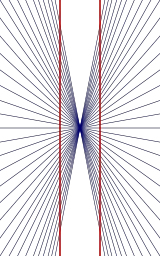Hering illusion
The Hering illusion is an optical illusion discovered in 1861. The two vertical lines are both straight, but they look as if they were bowed outwards. The Orbison illusion is a variant of the Hering illusion, as is the Wundt illusion. Although the Hering illusion and other similar illusions have not been completely explained, they has stimulated much valuable research into human perceptual processes. They have also been utilized by artists to bring about entertaining and impressive effects in their works.
Discovery
The Hering illusion is named for the German physiologist Ewald Hering, who first published the illusion in 1861.
Description
When looking at the illusion, the viewer appears to see a pair of bowed or curved lines placed in front of a series of other lines. In reality, these bowed lines are parallel, and only appear to be curved.
Explanation
The effect of the Hering illusion is often attributed to "angular displacement," where the perception of the straight parallel lines is skewed because of the effect of the angular lines surrounding them. The distortion may also be produced by the lined pattern on the background, which simulates a perspective design and creates a false impression of depth.
It has been observed that the illusion takes place when the image is horizontal or vertical, but is decreased when the image is rotated at an angle. This discovery has challenged traditional theories about how the illusory effect is generated.
Applications
Like many perceptual illusions, the Hering illusion helps neuroscientists study the mechanisms of perception. It also provides an intriguing experience for viewers, and as such has been utilized by artists in their works.
ReferencesISBN links support NWE through referral fees
- Baars, Bernard and Nicole Gage. 2007. Cognition, Brain, and Consciousness: Introduction to Cognitive Neuroscience. Academic Press. ISBN 0123736773
- Fineman, Mark. 1996. The Nature of Visual Illusion. Dover Publications. ISBN 0486291057
- Gregory, Richard L. 1997. Eye and Brain. Princeton University Press. ISBN 0691048371
- Ninio, Jacques. 2001. The Science of Illusions. Cornell University Press. ISBN 0801437709
- Robinson, J.O. 1998. The Psychology of Visual Illusion. Dover Publications. ISBN 978-0486404493
- Seckel, Al. 2000. Art of Optical Illusions. Carlton Books. ISBN 1842220543
External links
All links retrieved December 20, 2017.
- Hering Illusion Wolfram Math World
- Hering Illusion Visual Phenomena & Optical Illusions by Michael Bach
- The Hering Visual Optical Illusion Weird Optics
Credits
New World Encyclopedia writers and editors rewrote and completed the Wikipedia article in accordance with New World Encyclopedia standards. This article abides by terms of the Creative Commons CC-by-sa 3.0 License (CC-by-sa), which may be used and disseminated with proper attribution. Credit is due under the terms of this license that can reference both the New World Encyclopedia contributors and the selfless volunteer contributors of the Wikimedia Foundation. To cite this article click here for a list of acceptable citing formats.The history of earlier contributions by wikipedians is accessible to researchers here:
The history of this article since it was imported to New World Encyclopedia:
Note: Some restrictions may apply to use of individual images which are separately licensed.
